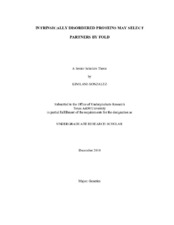| dc.contributor.advisor | Bondos, Sarah E | |
| dc.creator | Gonzalez, Kim 1988- | |
| dc.date.accessioned | 2013-06-04T16:10:25Z | |
| dc.date.available | 2013-06-04T16:10:25Z | |
| dc.date.created | 2010-12 | |
| dc.date.issued | 2010-12-08 | |
| dc.date.submitted | December 2010 | |
| dc.identifier.uri | https://hdl.handle.net/1969.1/ETD-TAMU-2010-12-9050 | |
| dc.identifier.uri | https://hdl.handle.net/1969.1/148757 | |
| dc.description.abstract | Intrinsically disordered proteins lack a rigid structure due to their simple amino acid sequence. Because of their multiple roles, disordered proteins often account for a majority of proteins known to be associated with various diseases. In particular, these unstructured proteins tend to have pivotal roles in protein-protein interactions that occur in cell signaling. For structured proteins, surface topology complementarities play a crucial role in the selection of protein interactions and stabilization of the interaction interface. In contrast, the mechanism through which intrinsically disordered proteins select binding partners still remains unresolved. To gain more knowledge of binding interactions of disordered proteins, we examined the binding tendencies of Ultrabithorax, Ubx, a Hox protein consisting of both structured and intrinsically disordered regions. Of the 33 known proteins bound by Ubx, 15 have only 3 of a possible 1200 folds, suggesting Ubx selects protein partners by topology. To determine whether the structured or disordered region mediate binding, and thus topological selection, we used a yeast two-hybrid system to evaluate the strength of interactions between Ubx and its binding partner. Results indicate that the intrinsically disordered regions of this protein are the reason for binding its partner. This is the first demonstration that surface topology is an important criterion for protein interactions involving intrinsically disordered regions. | en |
| dc.format.mimetype | application/pdf | |
| dc.subject | binding interactions | en |
| dc.subject | intrinsically disordered proteins | en |
| dc.subject | Ultrabithorax | en |
| dc.title | Intrinsically Disordered Proteins May Select Partners by Fold | en |
| dc.type | Thesis | en |
| thesis.degree.department | Biochemistry and Biophysics | en |
| thesis.degree.discipline | Genetics | en |
| thesis.degree.grantor | Honors and Undergraduate Research | en |
| thesis.degree.name | Bachelor of Science | en |
| dc.contributor.committeeMember | Hsiao, Hao-Ching | |
| dc.type.material | text | en |
| dc.date.updated | 2013-06-04T16:10:26Z | |


